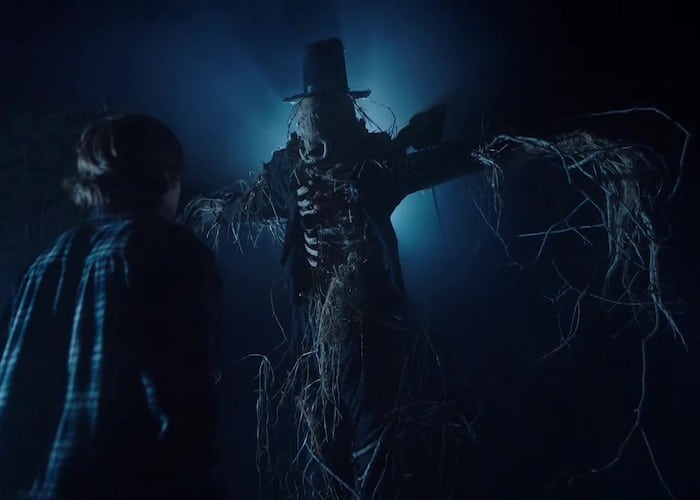
Creepshow—Shudder’s hotly-anticipated adaptation of George Romero and Stephen King’s 1982 horror anthology of the same name—is more than halfway done. So far, the episodic revamp has been something of a mixed bag, with the only consistency being the second segment tending to be the superior offering. Well boils and ghouls, good news: the curse is lifted! Bad news: like many a Creepshow monkey’s paw, everything has a price. This time, the first segment is good, but the second…might be the low point of the season so far.
Episode four’s good son, “The Companion,” is based on a short story from Bumper Crop, an anthology of personal favorites from splatterpunk scribe Joe Lansdale. Set in a small town that must be down the road from Derry, Maine, the segment follows Harold (Logan Allen), a tormented kid with a brute for an older brother. While Harold is catching his breath fishing down by the creek, his brother appears and gives chase, pursuing our terrorized teen onto an abandoned farm, home to a scarecrow liable to terrify more than just avian pests. Sure enough, Harold accidentally brings the damn thing to life (as one does) and finds himself trapped in the homestead, hunted by his brother and the creature. The scarecrow’s origins, it turns out, will be the key to confronting both.
“The Companion” ranks among the stronger showings from the season so far (a decidedly lonely bracket home to last week’s “The Man in the Suitcase” and not much else). It’s energetic, colorful, and features some of the series’ most compelling creature design. At no point during “The Companion” was I distracted by the quality of the performances, which is something few segments can say. In particular, “The Companion” features a turn by Afemo Omilami, who captures the earnest camp of the original anthology better than any other player thus far. His line deliveries feel like they’re written in comic book emphatics, and the goofier parts of the script are all the better for it. While not exactly a shock, the segment’s final blow feels more satisfying than the lukewarm stings of prior segments (looking at you “Bad Wolf Down”). That said, had there been some ambiguity or conflict about Harold’s final decision—the weakest point in the segment in terms of pacing—the ultimate payoff would have benefited greatly. All told: “The Companion” is an imperfect but respectable offering that easily hops over the low bar set by its predecessors.
The episode takes a nosedive in quality with its second segment, “Lydia Layne’s Better Half,” a revenge tale about a high-powered executive who accidentally kills her girlfriend and tries to dispose of the evidence only to wind up trapped in an elevator with the body. The segment is written by Tales from the Darkside: The Movie’s John Harrison and directed by Roxanne Benjamin, who produced and contributed to horror anthologies V/H/S and XX respectfully. The segment begins with the titular Lydia Layne (Battlestar Galactica‘s Tricia Helfer) offering a promotion to a male colleague instead of her to lover, Celia, who takes the rejection as a hypocritical betrayal from a self-professed shatterer of glass ceilings. The argument takes a turn, and Celia winds up dead. This act one drama takes itself very seriously despite being written and performed with the gravitas of a senior year acting class showcase. The desired effect is clearly some kind of escalating kettle whistle, but the execution is too plodding and amateurish to cash in that tonal check.
Things do not improve as the segment unfolds. Lydia’s motivations are never more complicated than “guess I gotta get rid of this corpse” and her actions fail to make contact with what little we know about her character. She is neither ruthless nor conflicted enough for any emotional stakes to take root, and the segment is frightfully uninteresting as a result. The overused fade-to-blacks don’t help with the segment’s pacing issues, which interrupt any possibility of the tension required to sell a Tell-Tale Heart format. Speaking of which: I’m all for supernatural fuzziness. But when Celia’s corpse starts to do creepy shit, it really feels like it’s just for the sake of doing creepy shit. There are plenty of potential avenues for the corpse shenanigans (Lydia’s guilt! Celia’s anger!) but none of these are executed well or clearly enough for them to tie the room together so to speak. As a result, the supernatural goings-on feels incidental to everything we’ve just seen. The segment clearly wants to say something about the insincerity of whitewashed corporate feminism, but Lydia’s success as a businesswoman and her failure to support her female colleague ultimately feel irrelevant to the way the plot unfolds. Begging the question: why frame this segment as a feminist critique in the first place?
With only a couple episodes left in the season, it’s unclear if Creepshow will be able to get its act together in time. Much of what we’ve seen so far has had the flavor of an undergraduate essay written the night before a deadline, in haste, with only a partial understanding of what the assignment was in the first place. There’s still time, and segments like “The Companion” give me hope. But let’s just say I’m not holding my breath.
Related Topics: Creepshow, Horror, Shudder

